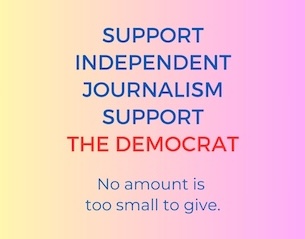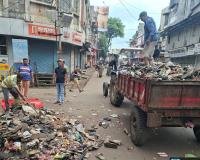- India
- Mind matters more than a machine: Prof. Subrata Roy Chowdhury
Mind matters more than a machine: Prof. Subrata Roy Chowdhury
By Shreya Palit Kolkata: Prof. Subrata Roy Chowdhury, one of the distinguished speakers of the ninth day of the #MediaNext2020 series of webinars, spoke on “Photography in Digital Times focusing.” on the Threats and Opportunities” amid Covid-19 pandemic. #MediaNext2020 is being organized by the Kolkata-based Adamas University in association with Sharda University, Birla Global University,

By Shreya Palit
Kolkata: Prof. Subrata Roy Chowdhury, one of the distinguished speakers of the ninth day of the #MediaNext2020 series of webinars, spoke on “Photography in Digital Times focusing.” on the Threats and Opportunities” amid Covid-19 pandemic.
#MediaNext2020 is being organized by the Kolkata-based Adamas University in association with Sharda University, Birla Global University, DME, AIMEC, Lok SamvadSansthan, exchange4media, ABP Education and IndiaReal.in, The mega conclave is being organized over a period of 10 days from June 1, 2020, to June 10, 2020. Each day of the conclave focuses on one specialized domain of the Media and Entertainment (M&E) industry along with the impact of the COVID-19 pandemic on that specific domain.
“Mind matters more than a machine. If we focus on enriching our minds during the pandemic, perhaps we can do better as individuals. When the entire world is gripped by problems such as unemployment, pay cuts, and huge monetary losses, photographers are not spared from these impacts,” said Prof. Roy Chowdhury, Head of the Department of Photography at Ramakrishna Mission Vidyamandira, Belur Math. He was delivering an insightful session on how to utilize the time in confinement owing to the COVID-19-induced lockdown that has paralyzed the entire world for the last two and a half months.
According to a renowned photography teacher of photography, the job of a photographer typically requires extensive travel and a high degree of human engagement. “A photographer’s ability of movement is severely restricted because of government regulations and transportation problems. He/she also has to take all precautionary measures to maintain personal well-being.”
Prof. Roy Chowdhury has been closely associated with his current institution for more than seven years. Besides being a principal resource person in many seminars and workshops, the distinguished teacher is also a documentary photographer and has worked on several prestigious national and international assignments. His article ‘May His Tribe Increase’ was published in an online magazine named ‘Private from France’ November 4, 2016.
One of his achievements includes receiving a ‘Performance Award’ in HPA 2013, an international photography competition jointly organized by China Folklore Photographic Association and UNESCO. He has conducted seven six-month Certificate Courses on Photography with a total participation of more than 600 students. However, he believes that the best he spends in a day when he spends time with his students and share his knowledge with them and encourage them to take an interest in documentary photography.
He thinks that in the prevailing pandemic situation, it becomes essential for photographers to come up with proper contingency plans along with the main plan. “Enforced confinement allows photographers to spend more time for introspection. This confinement time can be best utilized by engaging with film, literature, photography to gain imaginative interpretation of reality. Referencing arts and photographs of the past can provide a deep idea of how people have dealt with pandemics in the past,” he elaborated.
Focus on interpretation
In order to be successful, photographers should chase bold, imaginative interpretations of reality and artistic modes of representation, believes the master storyteller in photography. “Photographers should be resourceful and ready for experimentation to try things out of the box. A good approach would be standing and absorbing the spirit of the place, coming up with two or three adjectives to describe the spirit and trying to make the photographs a depiction of those adjectives. A good photographer should use metaphors and imageries to artistically depict emotions and make his/her work eternal,” he said.
According to him, the choice of correct colors, such as black and grey, is used as a sign of mourning and pink as a depiction of life.
Pandemic depictions in paintings
Pointing out the nuanced message in the paintings by the artist Edward Hopper such as Nightwalks (1942), Morning Sun (1952), Cape Cod Morning (1950), Prof. Roy Chowdhury analyzed that they perfectly depict lonely alienated individuals sitting in their self-contained apartments or empty restaurants staring at the empty city. “These paintings are an accurate description of our current pandemic situation. Individuals in these pictures can be thought of as ‘caged animals enclosed in their private boxes.’ These images of Copper have brought to life the situation of social distancing that the world is facing now,” he said.
He referred to the painting named ‘The Scream’ (1893) by Edvard Munich to exemplify the concept of the breakdown of dynamics among man, animal, and nature. “Its relevance with the COVID-19 pandemic situation by describing it as nature’s cry for help,” he explained.
Empathy and Compassion in Photography
Citing Rabindra Nath Tagore’s belief that was seeing demands introspection and a deep desire to lead a harmonious life in coexistence with nature and animals, he said: “The outer eye helps us to see the obvious and the inner eye enables us to feel compassion for human suffering, realize the fragility of human life and fully comprehend, visualize and communicate the effect of coronavirus on humanity.”
Quoting American Photographer Robert Frank, who said: “The eye should learn to listen before it looks,” Prof. Roy Chowdhury said that photographers need to empathize with their subjects to excel in their craft.
Importance of photography in pandemic
Pandemics like COVID-19 forces people to question their existence and ask questions such as “How to live?”, “How to make sense of the world?” and “How to face mortality?”. Photography is instrumental in bringing perspective and finding answers to such questions.
He believes that the photographs of people gasping for breath, dead people being stacked together, and put to graves unceremoniously in mass burials provoke important thoughts in the public who then realizes the need to question the current state of affairs. “They provide visual proof of important issues and raise important questions about the quality of our health facilities, reasons for these facilities being underfunded, and so on.”
Prof. Roy Chowdhury underlined the fact that one photograph speaks a thousand words by referring to photos of migrant workers who had walked hundreds of miles to reach their home-town but had not abandoned their pets. “This photograph was a strong depiction of basic humanity in poor people,” he signed off.
ooo













